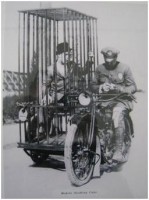Widgetized Section
Go to Admin » Appearance » Widgets » and move Gabfire Widget: Social into that MastheadOverlay zone
Coffee and Doughnuts: Building Accountability
The views expressed are those of the author and do not necessarily reflect the views of ASPA as an organization.
By John J. Carroll
April 10, 2015
 Most of the “mom and pop” doughnut shops are gone now. Thankfully, there is a coffee shop on every corner. Our main topic, Militarization of Law Enforcement, is an interesting take on an old topic and strikes me as a “no good deed goes unpunished” issue. With my first cup of coffee, I will look at accountability.
Most of the “mom and pop” doughnut shops are gone now. Thankfully, there is a coffee shop on every corner. Our main topic, Militarization of Law Enforcement, is an interesting take on an old topic and strikes me as a “no good deed goes unpunished” issue. With my first cup of coffee, I will look at accountability.
My perspective will probably be viewed as slanted. My service in law enforcement began in 1978 (that’s my first patrol car in the picture) and continued until 2010. After my time in the Air Force, I went to work for a sheriff’s office that grew into one of the largest in the nation. I served six sheriffs (five elected) from wide political persuasions and philosophies.
I learned firsthand how to balance the political and administrative (as well as the regular “crises du jour”). I was directly involved in crafting and implementing policies that affected all of our April topics (building accountability, managing community mistrust and skepticism). I hope this lends a bit of legitimacy to my view. The reader is of course free to agree or disagree.
According to the most recent Bureau of Justice statistics, there are almost 18,000 local police departments and sheriffs’ offices, employing over 1.13 million people (including 765,000 sworn personnel). Like it or not, American law enforcement agencies are the embodiment of our layered and diffused federalist structure. Building accountability throughout so many agencies is not only essential, but when done properly, a continuous and ongoing process. It is also nothing new.
The “professional model” of policing that developed from the Progressive Era is still evident today. An accountability “arc” can be drawn from the famous Knapp Commission that investigated corruption in the New York Police Department in the 1970s to the current Commission to Combat Police Corruption within city government. This arc is also national, whether internally or externally imposed (courts, state or federal monitors). Since 1993, law enforcement agencies have been at the forefront of embracing the outcome/results oriented management style (i.e., NYPD’s CompStat), which has accountability as the core element.
Law enforcement agency employees, particularly sworn ones, go through an incredibly rigorous hiring process. After hiring, the candidate must complete long and often stressful training before they begin to serve the public. As an example, an officer or deputy in Florida is required to hold a statewide certification, undergo regular training in high liability (driving, use of force, etc.), ethics and other important subjects. There is also opportunity for additional career enhancements and formal education.
Do people get through that who should not? Yes.
The agencies are also supposed to have detailed policies that outline actions and behaviors, court decisions and statutory requirements. Agencies are also supposed to have mechanisms in place to handle complaints against employees along with a process to correct behaviors and root out the bad apples. Agencies may avail themselves to external accrediting bodies and leadership development programs (FBI National Academy, Southern Police Institute, etc.).
Does this guarantee accountability? No.
Building accountability comes from leadership. Taking a leadership role in the public sector is an incredible balancing act between interests, resources and time. A leader has to balance internal factors (such as worker demographics, behaviors, processes, organizational structure and culture) and external ones (market/economic, technology, political, demographic shifts) that affect the agency. Many of these the leader has no direct control over although he/she is responsible for the actual service responsibilities of the agency.
Commissioners Bill Bratton, Raymond Kelly, Charles Ramsey, along with Chiefs Cathy Lanier, George Turner and Kathleen O’Toole have been leaders in their agencies during unprecedented events and are well-known for showing accountability.
Law enforcement agencies have added citizen review boards to help oversee them. Elected officials have become particularly sensitive to race, culture and other important aspects of relationships and behaviors in their agencies. There is discussion about deploying body cameras to all patrol officers – another technology that is not new – as an accountability effort. Early indications are that deploying this tool reduces use of force incidents and complaints against officers.
The continuous media drumbeat of a handful of high profile events may lead the public at large to believe there is a lack of accountability in its law enforcement agencies. This is simply not true. Hundreds of thousands of men and women go to work every day, like their millions of counterparts in other government agencies, believing they are doing their best to serve the public in an honest way. Enlightened leaders across the public sector know that building accountability is a continuous task, not a new one.
Author: John J. Carroll, Ph.D., is an assistant professor for public administration at Nova Southeastern University, in Fort Lauderdale, Florida. Before joining academia, he served in the public sector for more than 30 years. He is a retired deputy sheriff major and a veteran of the U.S. Air Force. His research and teaching interests include public administration from the “prac-ademic’s” perspective. Email: [email protected].


Follow Us!